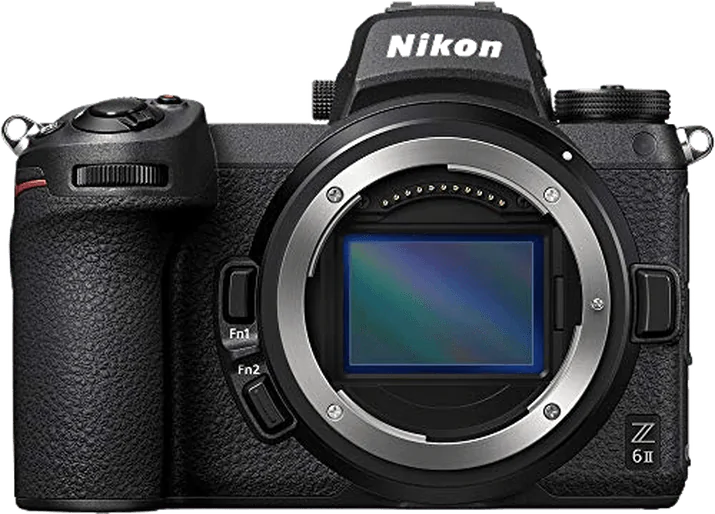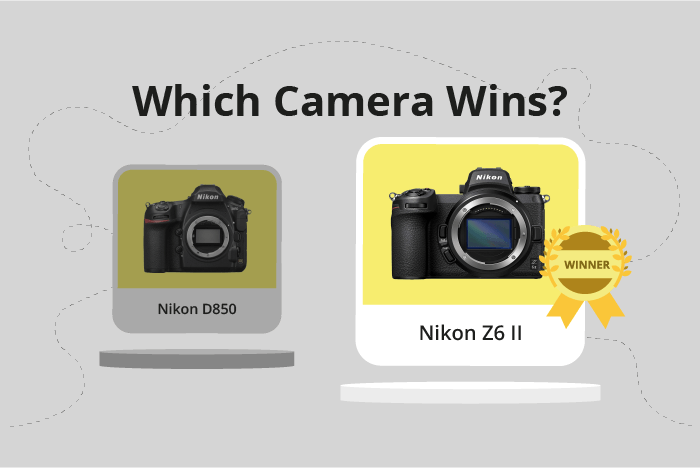Nikon D850 vs Z6 II Comparison
Nikon D850

Nikon Z6 II

The Nikon Z6 II edges out the Nikon D850 with a score of 83/100 compared to the D850’s 82/100. Both cameras share similarities in their specifications, such as being products of the Nikon brand and having high-quality imaging capabilities. However, the Z6 II is a mirrorless camera, while the D850 is a DSLR.
The Z6 II’s advantages include a more compact size (134 x 101 x 70mm) and lighter weight (705g), making it easier to carry and handle. Additionally, its release in 2020 and lower launch price of $1995 make it a more budget-friendly option.
On the other hand, the D850, released in 2017, boasts a more robust build (146 x 124 x 79mm) and heavier weight (1005g), which may appeal to photographers who prefer a sturdier camera. However, its launch price of $3300 is significantly higher than the Z6 II.
Taking these factors into account, the Nikon Z6 II is a better choice for those seeking a compact, budget-friendly option, while the Nikon D850 may be preferable for those who value a more substantial build.
Nikon D850 vs Z6 II Overview and Optics
The Nikon Z6 II outperforms the Nikon D850 in optics with a score of 83/100 compared to the D850’s 79/100. Both cameras share several specifications, including a CMOS sensor, full-frame sensor size, and the same brand lens mount (Nikon F FX for the D850 and Nikon Z for the Z6 II).
The Nikon Z6 II surpasses the D850 with its faster shooting speed of 14 frames per second (fps) compared to the D850’s 7 fps. Additionally, the Z6 II features a dual Expeed 6 processor, which contributes to its superior speed and performance. The Z6 II also boasts built-in image stabilization, providing an advantage for capturing sharp images in various conditions.
On the other hand, the Nikon D850 has a higher resolution with 45.7 megapixels compared to the Z6 II’s 24.5 megapixels. This allows the D850 to capture more detailed images. Furthermore, the D850 has a higher DXOMARK score for its sensor at 100, while the Z6 II scores 94, indicating better overall image quality.
While the Nikon Z6 II wins in terms of shooting speed, processing power, and image stabilization, the D850 excels in image resolution and sensor quality. The choice between these two cameras depends on the user’s priorities. For those who require fast shooting and image stabilization, the Z6 II is the better option. However, photographers who prioritize high-resolution images and superior sensor quality should opt for the D850.
Nikon D850 vs Z6 II Video Performance
The Nikon Z6 II outperforms the Nikon D850 in video capabilities with a score of 91/100 compared to the D850’s 70/100. Both cameras share some common specifications, such as a maximum video resolution of 4K and dimensions of 3840 x 2160. Additionally, both cameras have built-in time-lapse functionality.
The Z6 II has a significant advantage over the D850 due to its maximum video frame rate of 120fps, which is four times higher than the D850’s 30fps. This higher frame rate allows the Z6 II to capture smoother slow-motion footage and provides more flexibility in post-production editing. This difference in frame rate is a major contributing factor to the Z6 II’s higher video score.
The D850’s video capabilities are not entirely outclassed by the Z6 II, as they share the same 4K resolution and time-lapse functionality. However, the D850’s lower maximum frame rate limits its versatility in comparison to the Z6 II.
Taking these factors into account, the Nikon Z6 II is the clear winner for video performance due to its higher maximum frame rate of 120fps. The Nikon D850 remains a capable camera for video recording, but the Z6 II provides more flexibility and options for videographers in need of higher frame rates.
Nikon D850 vs Z6 II Features and Benefits
The Nikon D850 and the Nikon Z6 II both have a feature score of 87 out of 100, making them equally strong contenders in terms of features. They share several specifications, including a 3.2-inch screen size, touchscreen capability, absence of GPS, and the presence of WIFI and Bluetooth connectivity.
The D850 has a higher screen resolution at 2,359,000 dots compared to the Z6 II’s 2,100,000 dots. This results in a sharper and more detailed display on the D850, making it easier for photographers to review and edit their images directly on the camera.
On the other hand, the Z6 II does not have any standout features that make it superior to the D850 in this comparison. Both cameras have similar specifications, making them equally suitable for various photography needs. However, it is essential to consider other aspects, such as performance, optics, and video capabilities, when choosing between the two models.
In terms of features, the Nikon D850 and Nikon Z6 II are evenly matched, with the D850 having a slight edge in screen resolution. This similarity in features means that photographers should base their decision on other factors, such as their specific requirements, budget, and personal preferences. Both cameras are excellent options, and the choice ultimately depends on individual needs and priorities.
Nikon D850 vs Z6 II Storage and Battery
The Nikon D850 outperforms the Nikon Z6 II in storage and battery with a score of 84/100 compared to 71/100. Both cameras have two memory card slots and compatibility with UHS-II SD cards. The D850 accepts SD/SDHC/SDXC and XQD cards, while the Z6 II uses SD, CFexpress Type B, and XQD cards.
The D850’s superior battery life of 1840 shots, using the EN-EL15a battery, surpasses the Z6 II’s 410 shots with its EN-EL15c battery. This significant difference makes the D850 more reliable for extended shooting sessions. However, the Z6 II offers USB charging, providing a convenient option for on-the-go charging, which the D850 lacks.
Considering these factors, the Nikon D850 wins in storage and battery performance due to its longer battery life and versatile memory card compatibility. The Nikon Z6 II, while scoring lower, still has the advantage of USB charging for added convenience.
Alternatives to the Nikon D850 and Z6 II
Are you still undecided about which camera is right for you? Have a look at these popular comparisons that feature the Nikon D850 or the Nikon Z6 II:

